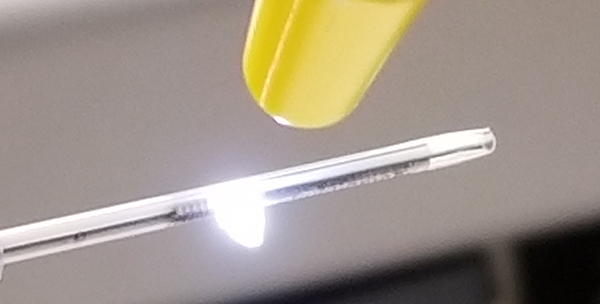Excimer lasers have taken a back seat to femtosecond and picosecond lasers when it came to catheter manufacturing, but it may be time for medical device creators to give this decades-old technology a second look.

“It looked like it was magically removed, without heat effect – like it was molded that way,” Hatcher recently told Medical Design & Outsourcing.
“Like it was made that way,” Kiefer added.
It’s that type of miniature magic that has Kiefer and Hatcher making a bet that as catheters increasingly get smaller and more complicated for neurological applications and a whole host of other delicate medical procedures, excimer lasers will have an important role to play in the manufacturing.
Hatcher’s medical device design startup Switchback Medical last year bought Kiefer’s five-person Kiefer Manufacturing operation. Daryl Kiefer now runs Proto Lase, a quick-turn laser processing service that utilizes 4,000 square feet of space adjacent to Switchback in the Minneapolis-St. Paul suburb of Maple Grove.
With an excimer laser, Kiefer boasts that he is able to use his roughly 20 years of the experience with the technology to get detailed jobs done in days that would take a larger outfit weeks to complete.
Excimer lasers have been around for more than 40 years and work well for high precision polymer ablation. The technology fell out of favor in catheter and other medical device manufacturing as cheaper manufacturing methods such as femtosecond and picosecond lasers came along, Kiefer said.
Excimer laser machines are high maintenance because they use a fluorine and neon gas mix that eats away at parts. Kiefer himself has to tear down Proto Lase’s machine every eight to 12 months.
Still, an excimer laser in the hands of an experienced technician can accomplish design feats that would be extremely difficult if not impossible with other manufacturing technologies, according to Kiefer.
Kiefer can use an excimer laser to ablate a design that someone would need an electron microscope to see.
“The detail that you can produce on a catheter tube is incredible, you could ablate your logo or name on it,” Hatcher said.
It really comes down to the development engineers understanding the capabilities of excimer lasers, Kiefer said. “There are a lot of ways that we can help them with design, and the excimer tool is a great tool to do that.”
Kiefer listed three things that excimer lasers are especially good at when it comes to catheter and medical tubing manufacturing:
1. Detailed holes and surface patterns

“We can do any type of hole pattern you want: rectangular, square, round, oval,” Kiefer said. “Whatever we put on that mask, that’s what you’re going to get. You can shoot that.”
A particular customer wanted a design on a polymer surface that would reduce surface contact between two substrates.
“We designed a custom screen to place in front of the path, and what comes out on the part is the exact same thing. It’s like milling on a lathe. It’s the same effect,” Kiefer said.
It’s possible to create such effects at sizes as small as 0.002 in., or roughly 50 microns, according to Kiefer.
“Femtosecond — there’s just so much energy that you’re not going to have that type of detail,” Kiefer said. Some manufacturers have started using mirrors to scan out a hole using femtosecond lasers, but it’s not the one-shot process that someone can get with an excimer laser.
2. Reducing outside diameter

“We’re going to ablate it down to a certain diameter and over a certain length,” Kiefer said.
Perhaps there’s a catheter shaft with a PTFE liner with a polyamide layer on top. It’s possible to reduce the diameter down to the PTFE for a certain length and then replace the polyamide along the length with another material that accomplishes a particular design goal along the particular length of catheter.
It’s this type of capability that makes excimer layers useful to strip extremely tiny wires before welding them to onto an electrode for, say, a pacemaker, Kiefer said.
3. Surface finish
It’s also possible to add extremely tiny surface patterns or roughen up a tubing surface in an extremely controlled way, according to Kiefer.
This surface preparation can be beneficial when bonding materials together, as it adds surface area to increase bond strength. It can also benefit in the reduction of surface tension when the product needs to release or slide over the finished surface.

